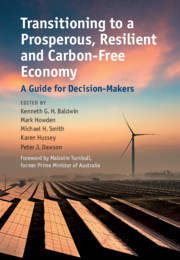Book contents
- Transitioning to a Prosperous, Resilient and Carbon-Free Economy
- Transitioning to a Prosperous, Resilient and Carbon-Free Economy
- Copyright page
- Dedication
- Contents
- Figures
- Tables
- Contributors
- Foreword
- Introduction
- 1 Policy Frameworks and Institutions for Decarbonisation: The Energy Sector as ‘Litmus Test’
- Technologies for Decarbonising the Electricity Sector
- Example Economies
- Cities and Industry
- 11 Cities
- 12 Buildings and Precincts
- 13 Urban Water
- 14 National Climate Change Adaptation Case Study: Early Adaptation to Climate Change through Climate-Compatible Development and Adaptation Pathways
- 15 Transport
- 16 Industry and Manufacturing
- Land Use, Forests and Agriculture
- Mining, Metals, Oil and Gas
- Addressing Barriers io Change
- Index
- References
11 - Cities
from Cities and Industry
Published online by Cambridge University Press: 08 October 2021
- Transitioning to a Prosperous, Resilient and Carbon-Free Economy
- Transitioning to a Prosperous, Resilient and Carbon-Free Economy
- Copyright page
- Dedication
- Contents
- Figures
- Tables
- Contributors
- Foreword
- Introduction
- 1 Policy Frameworks and Institutions for Decarbonisation: The Energy Sector as ‘Litmus Test’
- Technologies for Decarbonising the Electricity Sector
- Example Economies
- Cities and Industry
- 11 Cities
- 12 Buildings and Precincts
- 13 Urban Water
- 14 National Climate Change Adaptation Case Study: Early Adaptation to Climate Change through Climate-Compatible Development and Adaptation Pathways
- 15 Transport
- 16 Industry and Manufacturing
- Land Use, Forests and Agriculture
- Mining, Metals, Oil and Gas
- Addressing Barriers io Change
- Index
- References
Summary
Cities are responsible for over 70% of global greenhouse gas (GHG) emissions from energy use. Building and upgrading city infrastructure in developing countries could release 226 gigatonnes of carbon dioxide by 2050, if these cities obtain levels of infrastructure in developed countries today. Urban GHG emissions vary across economies, geography, wealth and urban form. The largest direct and indirect GHG emission sources are buildings, industry and transport. Urban climate change impacts of heat, sea-level rise, extreme weather, and water scarcity will exacerbate extant stressors in developing countries. Mitigation and adaptation measures interact, sometimes with unintended consequences. Systems approaches, integrated planning and strategy that recognises synergies and conflicts, are crucial to optimal outcomes. The city scale is good for innovation, aligned with national governance, for effective climate action. Many cities are committed to 100% renewable energy and net zero emissions by 2030. Key enablers are: a shared city region vision; effective stakeholder engagement; relevant, credible, accessible knowledge for decision-making; and aligned institutional arrangements.
- Type
- Chapter
- Information
- Transitioning to a Prosperous, Resilient and Carbon-Free EconomyA Guide for Decision-Makers, pp. 271 - 300Publisher: Cambridge University PressPrint publication year: 2021

